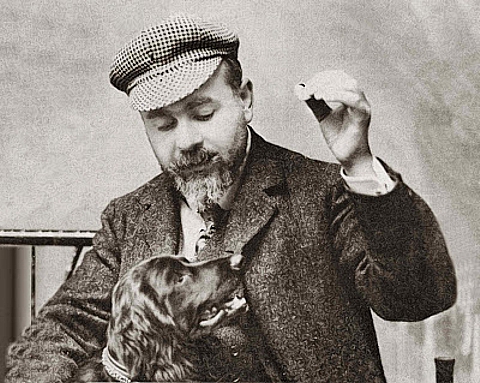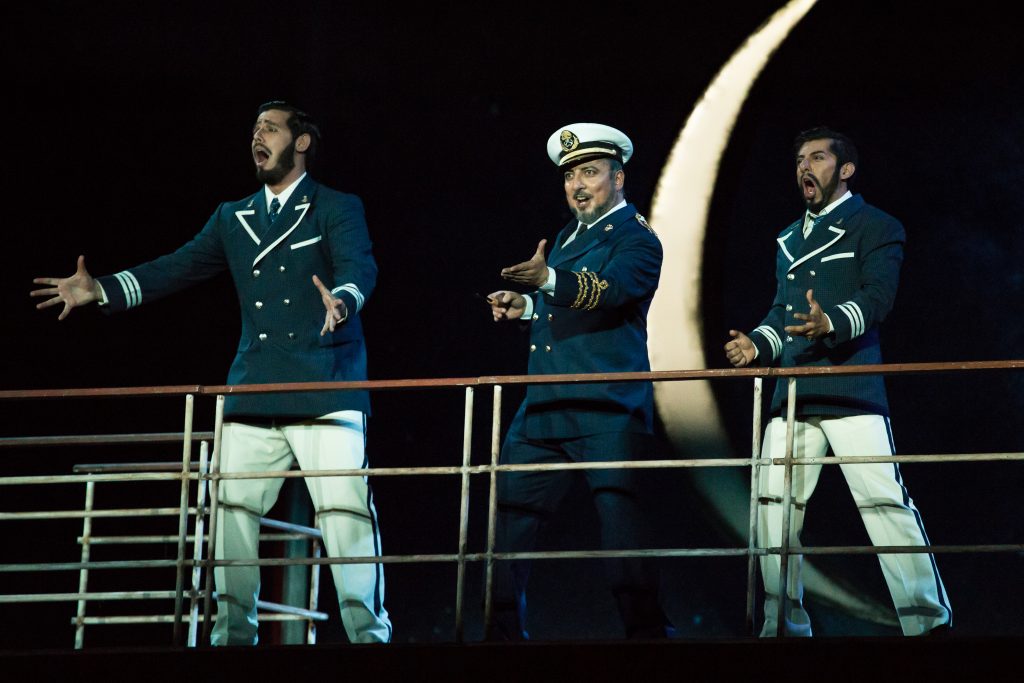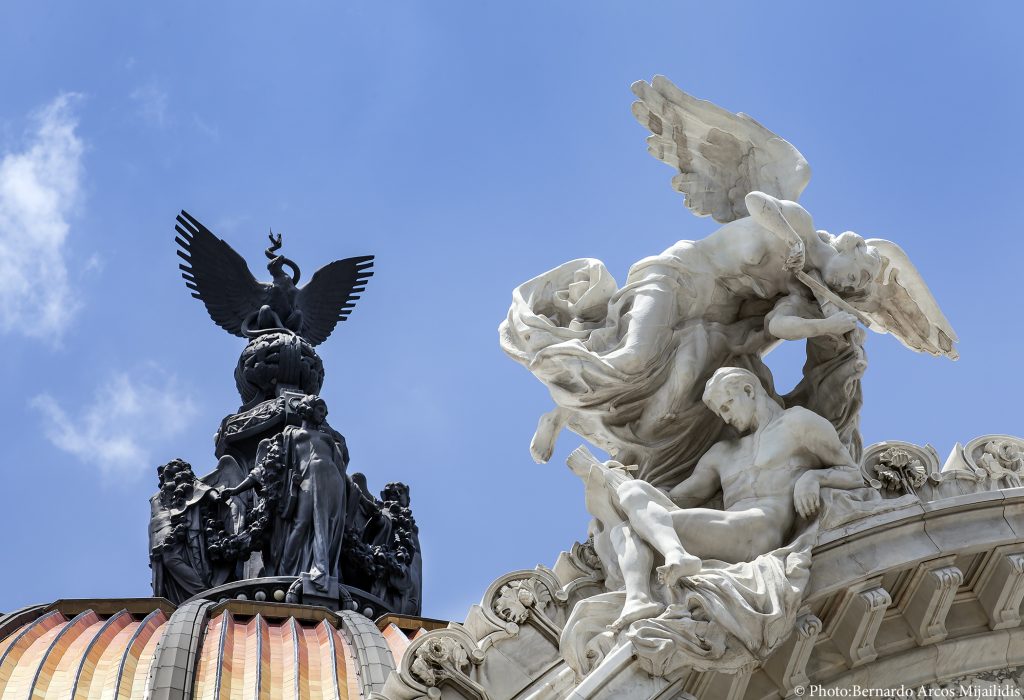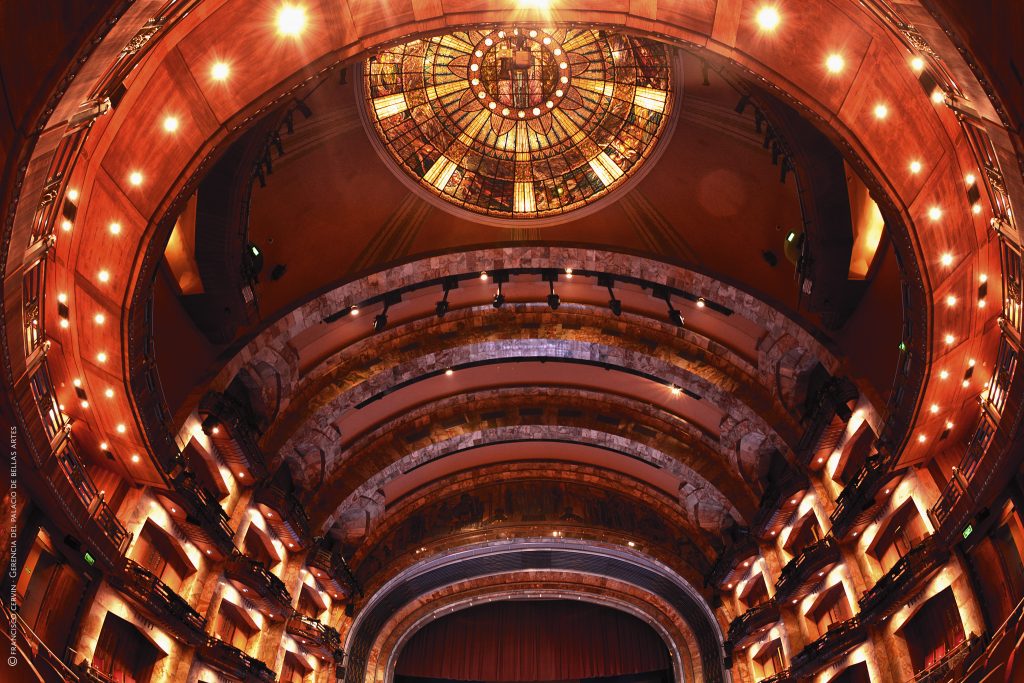Palacio de Bellas Artes de México, entre la herencia mestiza y la diversidad de las culturas
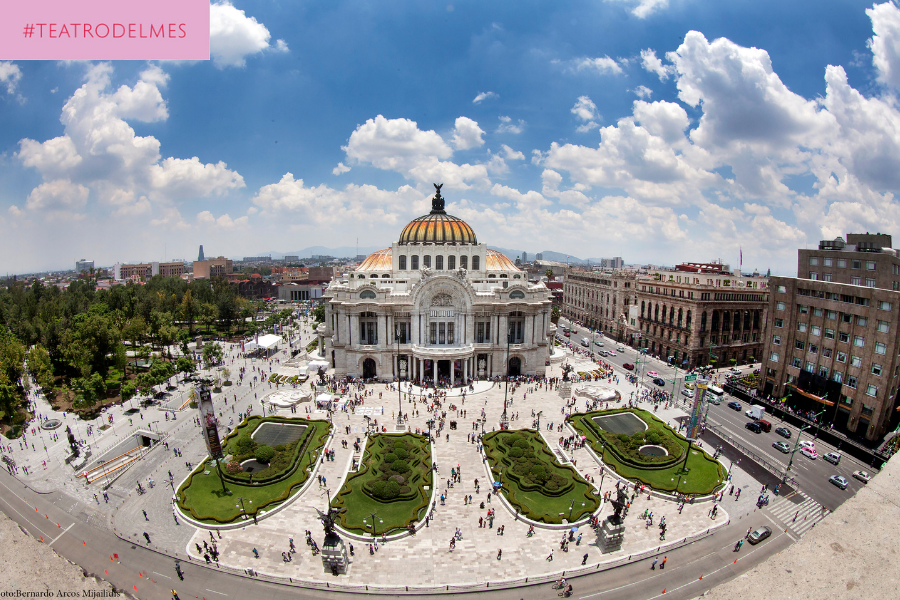
La historia del Palacio de Bellas Artes de México tiene una singular dinámica, entrelazada por dos épocas fundamentales en la historia del país: el régimen de Porfirio Díaz y la Revolución Mexicana. Su construcción también está marcada por el desarrollo y embellecimiento de la Ciudad de México, en un marco de modernización propio de las sociedades latinoamericanas de inicios del siglo XX. Debido a las diferentes etapas -y épocas- en su construcción, el edificio cuenta con diferentes estilos arquitectónicos que se imponen en medio del centro histórico de la capital mexicana. Hoy, el Palacio de Bellas Artes, el gran monumento a la cultura del país, alberga diferentes salas, escenarios e instituciones artísticas, entre las que destaca la Compañía Nacional de Ópera (Ópera de Bellas Artes), una de las más importantes a nivel continental por su contribución al desarrollo de la lírica en México.
En mayo de 1950, el Palacio de Bellas Artes de México fue testigo de un recordado momento en la historia de la ópera. La soprano italiana Maria Callas encumbraba su carrera lírica a nivel internacional y, en el marco de una gira que la llevó por diferentes países, visitó el gran palacio cultural de la capital mexicana para cantar las óperas Norma, de Bellini, y Aída, de Verdi. Al final del segundo acto de la obra verdiana, la artista intercaló un célebre mi bemol semiagudo que, según cuenta el mito, fue una venganza contra el tenor Kurt Baum, quien también era parte del elenco y habría hecho algo, inexplicable y desconocido, que colmó la paciencia de Callas. El público, deslumbrado, se rindió ante la diva italiana en un arrebato de aplausos y la grabación pasó a la historia.
Maria Callas se presentó en el Palacio de Bellas Artes dos veces más, en 1951 y 1952. Por ese entonces, el teatro ya se había consolidado como la principal institución artística de un país que estaba experimentando un periodo de crecimiento y desarrollo milagroso. El escenario de Bellas Artes era altamente cotizado en el circuito internacional de la cultura. Cantantes líricos del nivel de Luciano Pavarotti, Plácido Domingo, Marilyn Horne o Teresa Berganza también forman parte de las legendarias presentaciones que ha albergado este icónico palacio.
La historia, sin embargo, va más allá de la cultura y las artes y las anécdotas de divas internacionales, y se entrecruza con hitos políticos y sociales que marcan la tradición de México. El régimen de Porfirio Díaz, la consecuente Revolución mexicana, las tomas de posesión de presidentes como Adolfo Ruiz Cortines (1952) o Gustavo Díaz Ordaz (1964) y la fundación del Instituto Nacional de Bellas Artes (INBA) en 1946, son algunos de los eventos en los que el palacio, de alguna u otra manera, ha estado presente para, hasta el día de hoy, convivir con la memoria de un México que, orgullosamente, rescata su patrimonio.
El camino hacia un teatro nacional
Durante los primeros años en que México comenzaba a construir una república independiente, el militar y político Antonio López de Santa Anna inauguró la primera gran obra arquitectónica dedicada a la cultura en el país. El Gran Teatro de Santa Anna -bautizado así en un delirio de megalomanía- abrió sus puertas al público en 1844. Posteriormente, cuando decayó la popularidad de López de Santa Anna, el teatro pasó por sucesivos cambios de nombre según quién estuviera en el cargo: se le llamó Gran Teatro de Vergara, Gran Teatro Imperial durante el Segundo Imperio de México de Maximiliano I y finalmente, con la restauración de la República, quedó con el distintivo de Gran Teatro Nacional.
A inicios del siglo XX, se advenían las celebraciones del centenario de independencia de muchas naciones latinoamericanas. Al igual que otras capitales del continente, la Ciudad de México entró en un proceso de embellecimiento, modernización y recepción de influencias arquitectónicas de la Europa del nuevo siglo. Arquitectos, ingenieros y diseñadores europeos visitaron el país para contribuir con el diseño y la construcción de nuevos edificios que resaltaran la grandeza y progreso de los estados.
El año 1900, el ingeniero mexicano Gonzalo Garita y el arquitecto italiano Adamo Boari presentaron proyectos al Gobierno mexicano para remodelar el Gran Teatro Nacional en el marco del festejo del centenario independista. Las autoridades del porfiriato, no obstante, optaron por demoler el antiguo teatro en 1904 y construir un edificio totalmente nuevo. En 1905, se puso la primera piedra del nuevo Teatro Nacional, el que aún tendría un largo recorrido para finalizar su construcción y convertirse en el emblema cultural que es hoy en día.
De la Revolución al Art Déco
El estallido de la Revolución mexicana en 1910 generó un periodo de agravamiento de las condiciones económicas de México y la inestabilidad política y social ralentizó el ritmo de construcción del nuevo Teatro Nacional. El arquitecto Adamo Boari optó por regresar a Europa en medio de un clima turbulento y enardecido. La obra tenía concluido casi todo su exterior, salvo la cúpula, la cual todavía debía ser recubierta.
A pesar de que el teatro aún estaba incompleto, se erigió como un importante centro de acontecimientos de la sociedad mexicana, siendo el lugar elegido para celebrar distintos actos cívicos y políticos. Con este entusiasmo, poco a poco fue ganando interés la idea de terminar la construcción.
La recuperación financiera de las instituciones y los estados mexicanos en la posrevolución dio paso a una era que iniciaría el camino del país hacia el desarrollo social, político, económico y cultural. Durante la década de los treinta, en México se consolidó la naciente burguesía industrial en paralelo al avance de políticas económicas reformistas. Durante la presidencia de Pascual Ortiz Rubio y el apoyo del entonces secretario de Hacienda, Alberto Pani Arteaga, se revitalizó el proceso para consolidar la construcción del teatro.
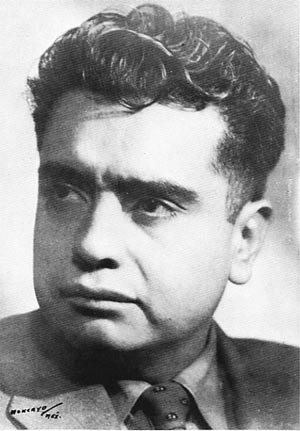
El pianista y compositor mexicano José Pablo Moncayo, autor de óperas como «La mulata de Córdoba». Foto: Creative Commons.
El arquitecto mexicano Federico Mariscal Piña fue el encargado de concluir la obra, con las instrucciones de “concebir un edificio asiento de una institución nacional de carácter artístico”. No solo albergaría museos, sino que se convertiría en el principal centro público de divulgación de las artes y las culturas en el país. El sello arquitectónico y artístico, por su parte, fue una redefinición mexicana de la corriente Art Déco, un paso lógico del Art Nouveau modernista. Así, el proyecto pasaría a llamarse como lo conocemos hoy: Palacio de Bellas Artes de México, inaugurado el 29 de noviembre de 1934.
Ópera hecha en México
Según relata el escritor mexicano Jaime Bali Wuest:
“Era el 29 de [noviembre] de 1934 cuando el presidente y su comitiva se instalaron cómodamente en el palco de honor, el reloj marcaba las 10 horas con diez y siete minutos. Al interior del recinto, que mostraba butacas vacías y mientras el público presionaba para entrar, se escucharon las notas del Himno Nacional interpretado por un coro de mil voces acompañado por la Orquesta Sinfónica, bajo la dirección de Carlos Chávez. En seguida se escucharon las palabras de don Antonio Castro Leal, jefe del Departamento de Bellas Artes. Sin tardanza la sinfónica interpretó la Sinfonía Proletaria del maestro Chávez, con el título de Llamadas. Después vino una breve intervención del Presidente de la República, general Abelardo L. Rodríguez, declarando formalmente inaugurado el recinto” (Bali, 2010)
La vida cultural mexicana comenzó a consolidarse también en la institucionalidad. En 1946, se fundó el Instituto Nacional de Bellas Artes (INBA), un organismo gubernamental dedicado al fomento, desarrollo y difusión de las artes y la cultura en México. Entre los diferentes grupos artísticos que alberga el Palacio de Bellas Artes, a través de su Instituto, está, por supuesto, la Compañía Nacional de Ópera (Ópera de Bellas Artes), fundada en 1948 y cuya primera función fue una producción de Tosca de Giacomo Puccini ese mismo año.
La ópera en Mexico ya había recorrido su propio trecho. La Parténope, de Manuel de Sumaya, fue la primera ópera escrita en el país, en 1711. Luego, durante el siglo XIX, se desarrolló el periodo de la “ópera decimonónica”, en el que destacan obras como Catalina de Guisa, de Cenobio Paniagua, Ildegonda, de Melesio Morales, y Atzimba, de Ricardo Castro. Posteriormente, con la inauguración del INBA, el fomento a la lírica por parte de la Compañía Nacional de Ópera se tradujo en estrenos de destacadas óperas mexicanas del siglo XX, entre las que se encuentran Elena de Eduardo Hernández Moncada, Carlota de Luis Sandi y La mulata de Córdoba de José Pablo Moncayo, con libreto de Agustín Lazo y Xavier Villaurrutia.
A lo largo de los siglos XX y XXI, el Palacio de Bellas Artes ha albergado una diversidad de experiencias artísticas y culturales que lo convierten en el principal foco de desarrollo de la cultura -y la lírica- en el país. Ha sido sede de estrenos mundiales de óperas mexicanas como La mujer y su sombra (1981) de Miguel Alcázar, La Güera (1982) de Carlos Jiménez Mabarak y, más recientemente, El juego de los insectos (2009) de Federico Ibarra. A su vez, del INBA dependen grupos artísticos como la Orquesta Sinfónica Nacional, la Compañía Nacional de Danza, la Ópera de Bellas Artes, el Coro de Madrigalistas y la Orquesta de Cámara de Bellas Artes, entre otros.
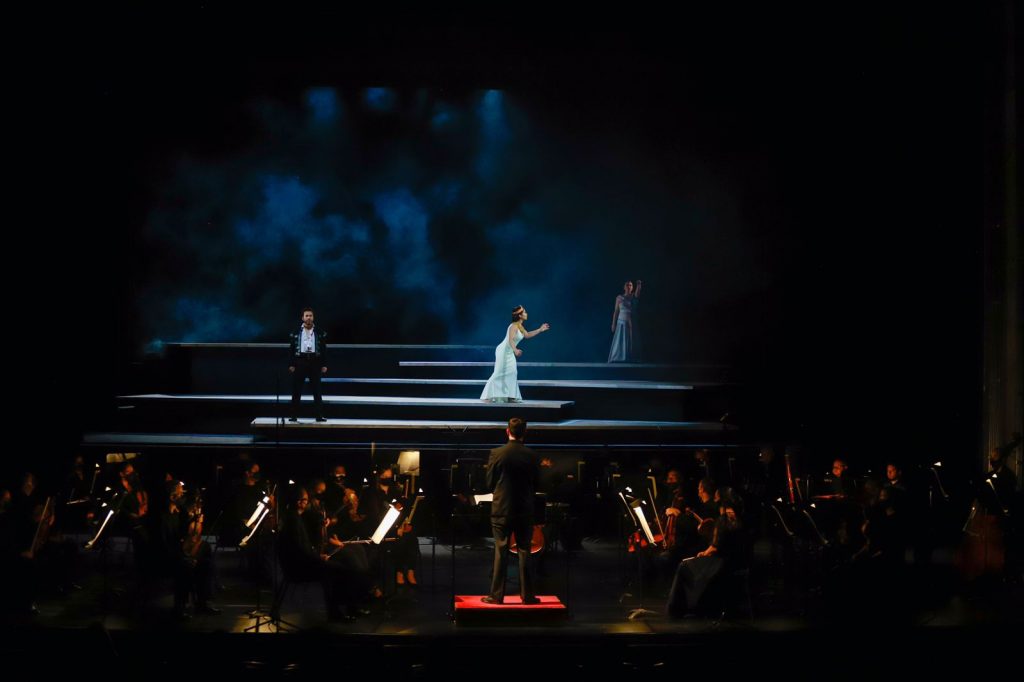
La ópera «Montezuma», con una producción semiescenificada de Ruby Tagle estrenada en 2021. Foto: Palacio de Bellas Artes, Ópera de Bellas Artes.
Hoy, el Instituto es dirigido por la destacada Doctora en Ciencias Antropológicas Lucina Jiménez López, mientras que la compañía de ópera está a cargo de Alonso Escalante Mendiola, quien ya venía de impulsar la ópera en el Teatro del Bicentenario y detonar la actividad lírica en la región céntrica de México. En el último tiempo, a medida que paulatinamente se han levantado las restricciones por la pandemia de COVID-19, el Palacio de Bellas Artes ha recuperado óperas de repertorios barrocos como, por ejemplo, Montezuma de Carl Heinrich Graun, con puesta en escena de Ruby Tagle y la conducción del maestro Iván López Reynoso.
Una arquitectura para recorrer el mestizaje y la modernidad
En pleno Centro Histórico, en la Avenida Juárez, luego de una gran explanada y plaza que le compite en tamaño y magnificencia al Zócalo de la Ciudad de México, se ubica este imponente palacio de las artes y la cultura mexicana. Desde el exterior, el edificio muestra inmediatamente un estilo de Art Nouveau mexicanizado, con un aspecto escultórico que le da toques nacionalistas y de grandeza, elementos clave para resaltar como identidad arquitectónica durante sus diferentes etapas de construcción.
Los ornamentos de la fachada están inspirados en la flora y fauna de México, además de motivos de origen prehispánico que también están presentes al interior. En ese mismo espacio, se encuentran adornos y decorados realizados por escultores y artistas como André Allar, Paul Gasq, Leonardo Bistolfi y el arquitecto original del teatro, Adamo Boari.
El interior del Palacio de Bellas Artes es un ecléctico espectáculo de estilo y diseño. Influido por las tendencias del Art Nouveau y Art Déco, las formas geométricas y líneas rectas subrayan los espacios y salas. Los muros, pisos y columnas que recorren el edificio están revestidos de mármol mexicano de variados colores y traídos de diferentes zonas del país como Querétaro, Nuevo León, Durango y Guerrero. La cúpula que corona el vestíbulo es un grandioso armazón de metal. Cobre, ónix y cerámica cubren esta armadura y dan la sensación de estar observando un caleidoscopio de emociones alimentadas por los colores que se entrecruzan. La magia del interior también se realza con los mascarones de Chaac, la deidad maya que entrega la lluvia. Otro mascarón, esta vez de Tláloc, el dios teotihuacano también de la lluvia adorna el acceso al vestíbulo de la sala de espectáculos.
En esta sala, con plafón de cristal en la cúpula interior, aparece majestuoso el telón de estructura metálica. Como describe la periodista mexicana Miriam Vidal, la cortina “sostiene un enorme mosaico de vidrio opalescente […] Mas de un millón de cristales de dos centímetros cuadrados dan forma a una panorámica del Valle de México, inspirada en una obra de Gerardo Murillo”.
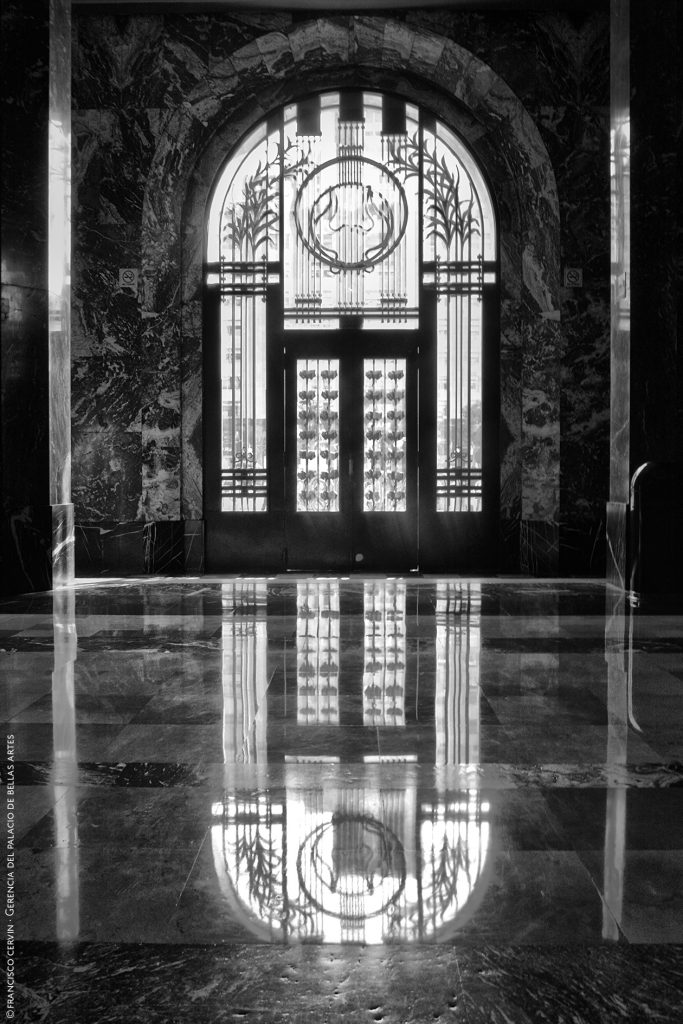
Pasillo del Palacio, que destacan por las estructuras revestidas de mármol mexicano. Foto: Francisco Cervin – Gerencia del Palacio de Bellas Artes.
Además de las salas de espectáculos, en el tercer y cuarto piso del Palacio de Bellas Artes se encuentran espacios de exposiciones y uno de los orgullos más grandes del edificio: la colección de murales de destacados artistas mexicanos como Diego Rivera (El hombre controlador del universo, 1934), David Alfaro Siqueiros (La nueva democracia, 1945) y Jorge González Camarena (Liberación o La humanidad se libera de la miseria, 1963).
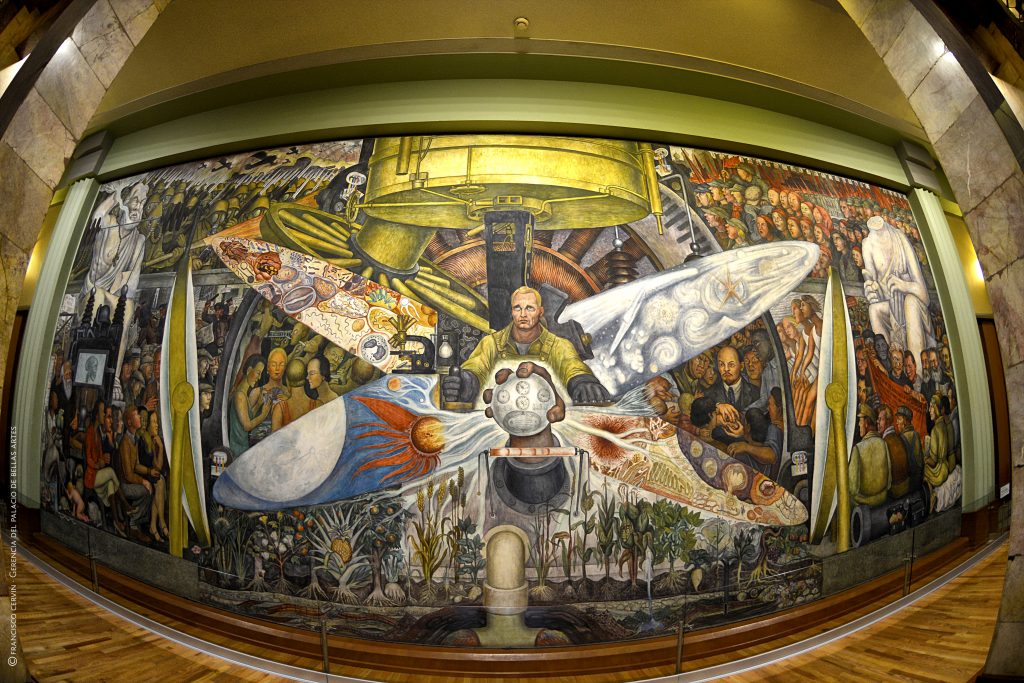
«El hombre controlador del universo», mural de Diego Rivera en la colección permanente del Palacio de Bellas Artes. Foto: Francisco Cervin – Gerencia del Palacio de Bellas Artes.
Todo este patrimonio arquitectónico, artístico y cultural, además de una historia atravesada por la contingencia social, política y económica de México, convierten al Palacio de Bellas Artes en una fascinante sinergia de sentidos, emociones y exaltación de la herencia mestiza que marca la identidad del país.


